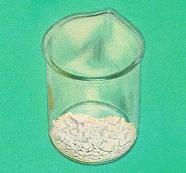Chemistry:Protactinium(V) oxide
From HandWiki

| |
| Names | |
|---|---|
| IUPAC name
Protactinium(V) oxide
| |
| Identifiers | |
3D model (JSmol)
|
|
| |
| |
| Properties | |
| Pa2O5 | |
| Molar mass | 542.0688 g mol−1 |
| Appearance | White, opaque crystals |
| Structure | |
| cubic | |
| Fm-3m, No. 225 | |
| Hazards | |
| Main hazards | highly toxic, radioactive |
| GHS pictograms |   
|
| NFPA 704 (fire diamond) | |
Except where otherwise noted, data are given for materials in their standard state (at 25 °C [77 °F], 100 kPa). | |
| Infobox references | |
Protactinium(V) oxide is a chemical compound with the formula Pa2O5. When it is reduced with hydrogen, it forms PaO2. Aristid V. Grosse was first to prepare 2 mg of Pa2O5 in 1927.[1] Pa2O5 does not dissolve in concentrated HNO3, but dissolves in HF and in a HF + H2SO4 mixture and reacts at high temperatures with solid oxides of alkali metal and alkaline earth metals.[2][3]:195
As protactinium(V) oxide, like other protactinium compounds, is radioactive, toxic and very rare, it has very limited technological use. Mixed oxides of Nb, Mg, Ga and Mn, doped with 0.005–0.52% Pa2O5, have been used as high temperature dielectrics (up to 1300 °C) for ceramic capacitors.[3]:189
References
- ↑ "Protactinium". http://www.3rd1000.com/elements/Protactinium.htm.
- ↑ Sellers, Philip A.; Fried, Sherman; Elson, Robert E.; Zachariasen, W. H. (1954). "The Preparation of Some Protactinium Compounds and the Metal". Journal of the American Chemical Society 76 (23): 5935–5938. doi:10.1021/ja01652a011. https://digital.library.unt.edu/ark:/67531/metadc172625/.
- ↑ 3.0 3.1 Boris F. Myasoedov, H. W. Kirby, & Ivan G. Tananaev (2006) Protactinium, Chapter 4 in Morss, Lester R. & Edelstein, Norman M. & Fuger, Jean, (edit.) The Chemistry of the Actinide and Transactinide Elements (PDF) (3. painos). Dordrecht: Springer. ss. 161–252.
 |


